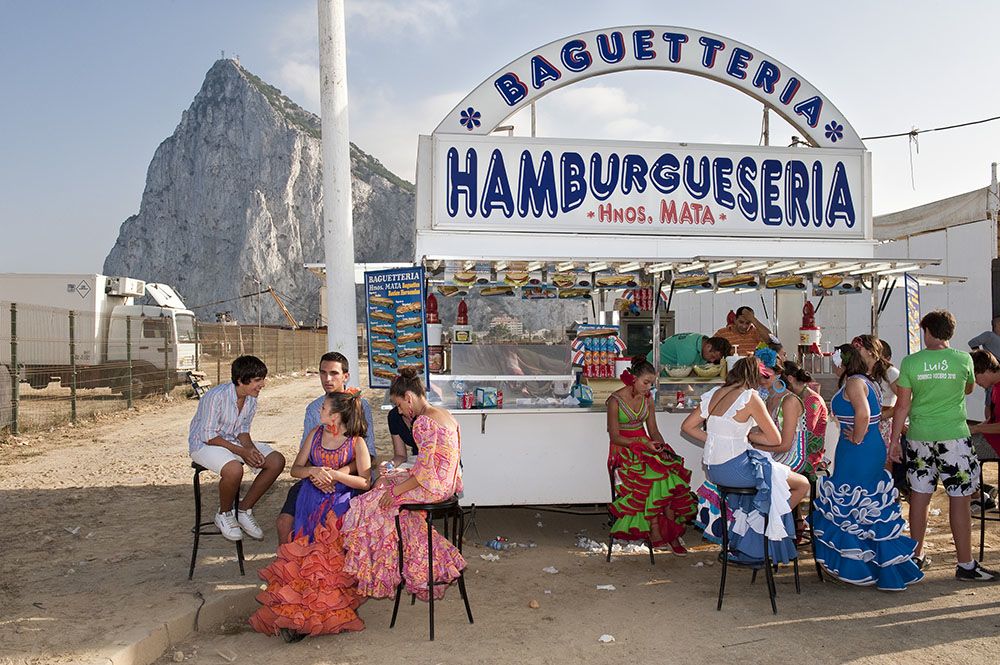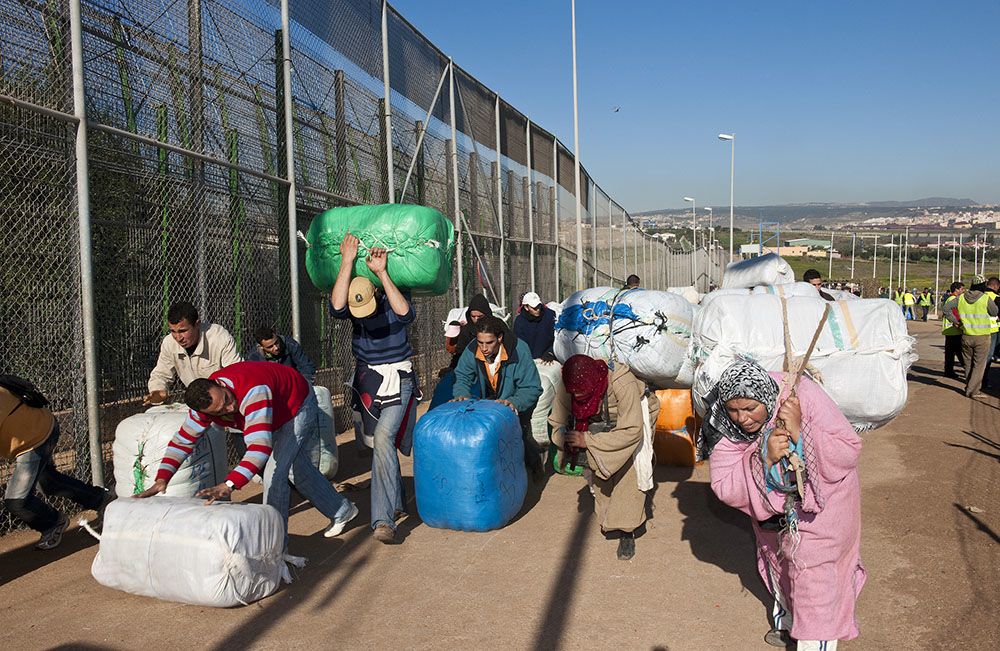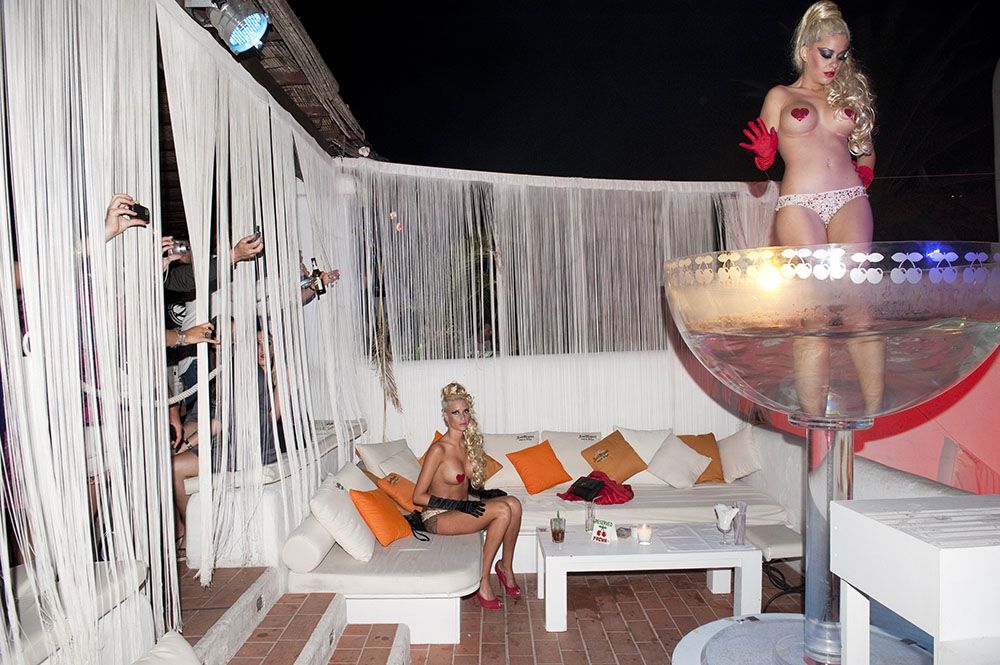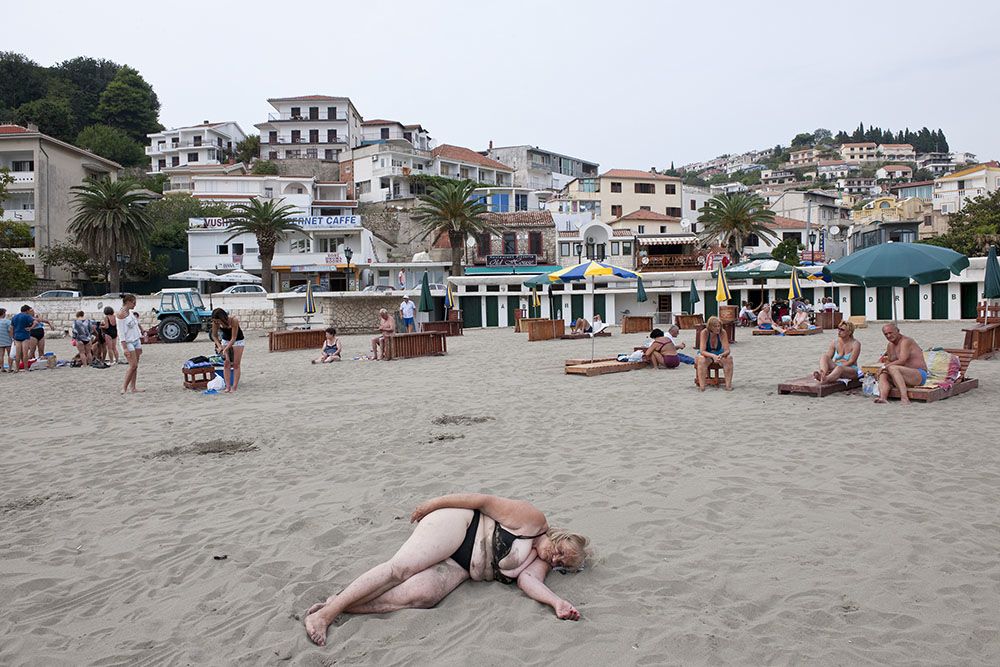For most of the past three years, Antwerp-based photographer Nick Hannes has been traveling across the Mediterranean coastline photographing the locals, the immigrants, the tourists, and the escalating urbanization that have been interfering with its landscape, for a project he's called Mediterranee. I only heard about him a month or two ago, however, when this photo (below) taken at a wedding held at a Greek gas station went viral on the internet.
Advertisement
I don't know if it was the image of the lady smoking next to the gas pumps, or just the world's inclination to make fun of the Greeks these days that made it so popular. But, in my eyes, it was a beautiful picture. So, I had a look at his website to find that the rest of Mediterranee is equally impressive and convinced myself that I had to call him up for a chat.VICE: Hey Nick. What was it that made you want to study the Mediterranean coastline so extensively?
Nick Hannes: Well, one reason was that in my previous project I focused on the area that previously made up the Soviet Union. I don't like to jump from one continent to another one and I was fascinated by the region already, having read about its ancient history. Another reason is I was looking for a long-term project. There's about 20 countries that border the Mediterranean sea, I’ve been working on this since 2010, and I think I have at least one more year ahead of me.
Nick Hannes: Well, one reason was that in my previous project I focused on the area that previously made up the Soviet Union. I don't like to jump from one continent to another one and I was fascinated by the region already, having read about its ancient history. Another reason is I was looking for a long-term project. There's about 20 countries that border the Mediterranean sea, I’ve been working on this since 2010, and I think I have at least one more year ahead of me.

How do you go about it? Do you only visit each country once or is it a case of going back and forth?
No, I try to do every country only once because it would be too much otherwise. There are still some countries I haven’t visited, like Lybia, Algeria, Italy, and France. I’m not so sure I’ll end up going to Syria, so I might have to do it with some archive photos from past travels. I can only travel in summertime too, which is why it takes me so much longer to get around. I was about to ask why your pictures seem to have only been taken in the summer.
I teach Documentary Photography at the Academy of Arts in Gent, Belgium, and that keeps me at home during the school year. But not all the pictures are taken in summer. I can always escape during the school holidays, mid-year, for a while so I travel then, too. What I like most about this project is it covers so many themes and issues, it’s hard to find one thing that binds them together visually. Except maybe for the landscape.
For one, I try to avoid stereotypes. I play with them sometimes, but I try to turn them around. My aim is to make photographs that are not readable in just one second. Of course, there are certain topics that interest me, like migration and the natural landscape coming into conflict with urbanization, but the project is more about a certain human condition. What are we, as human beings, doing with our public space—how are we organizing our society?
No, I try to do every country only once because it would be too much otherwise. There are still some countries I haven’t visited, like Lybia, Algeria, Italy, and France. I’m not so sure I’ll end up going to Syria, so I might have to do it with some archive photos from past travels. I can only travel in summertime too, which is why it takes me so much longer to get around. I was about to ask why your pictures seem to have only been taken in the summer.
I teach Documentary Photography at the Academy of Arts in Gent, Belgium, and that keeps me at home during the school year. But not all the pictures are taken in summer. I can always escape during the school holidays, mid-year, for a while so I travel then, too. What I like most about this project is it covers so many themes and issues, it’s hard to find one thing that binds them together visually. Except maybe for the landscape.
For one, I try to avoid stereotypes. I play with them sometimes, but I try to turn them around. My aim is to make photographs that are not readable in just one second. Of course, there are certain topics that interest me, like migration and the natural landscape coming into conflict with urbanization, but the project is more about a certain human condition. What are we, as human beings, doing with our public space—how are we organizing our society?
Advertisement

What have you learned so far, then?
Well, most of the coastline is completely urbanized. I imagine that is become of tourism, right?
That’s one thing, but also because of geography and logic. There’s been a lot of activity along the shore since ancient times, because of the ports that allow for cultures to mix and commerce to grow. Tourism is a far more recent phenomenon. In Spain or Albania, the coast is basically a building site. Greece is OK; I didn't see the same signs of urbanization that I saw everywhere else. Do you think that has something to do with the economic crisis?
No, that's too recent. I think it’s more to do with having the brains not to spoil the landscape. Some countries only care about making money.
Well, most of the coastline is completely urbanized. I imagine that is become of tourism, right?
That’s one thing, but also because of geography and logic. There’s been a lot of activity along the shore since ancient times, because of the ports that allow for cultures to mix and commerce to grow. Tourism is a far more recent phenomenon. In Spain or Albania, the coast is basically a building site. Greece is OK; I didn't see the same signs of urbanization that I saw everywhere else. Do you think that has something to do with the economic crisis?
No, that's too recent. I think it’s more to do with having the brains not to spoil the landscape. Some countries only care about making money.

What about in terms of behavior, were there any similarities among the cultures?
The only major similarity I noticed is that people who live along the coast are a lot more religious. I don't know if that's anything to do with the sea. Family values are a lot more important to people there as well. But, I don't think that there is just one Mediterranean identity; it’s an extremely diverse area. As for the landscape, which you mentioned before, that is in fact similar. I also made a conscious effort not to photograph any famous landmarks. I don't want people to look at the photos and see that it’s Spain or whatever, instantly. The Mediterranean has always been a place of conflict. Do you think there’s any particular reason for that?
I don't know if there is more unrest there than in other places in the world. I don't think so. But also I have a fascination with conflict and places that have been centers of civil or sovereign dispute. And that was the case in a lot of the places I visited. You could feel it when you walked around; Cyprus is a great example of that.
The only major similarity I noticed is that people who live along the coast are a lot more religious. I don't know if that's anything to do with the sea. Family values are a lot more important to people there as well. But, I don't think that there is just one Mediterranean identity; it’s an extremely diverse area. As for the landscape, which you mentioned before, that is in fact similar. I also made a conscious effort not to photograph any famous landmarks. I don't want people to look at the photos and see that it’s Spain or whatever, instantly. The Mediterranean has always been a place of conflict. Do you think there’s any particular reason for that?
I don't know if there is more unrest there than in other places in the world. I don't think so. But also I have a fascination with conflict and places that have been centers of civil or sovereign dispute. And that was the case in a lot of the places I visited. You could feel it when you walked around; Cyprus is a great example of that.
Advertisement

See, that’s what I’m talking about. You have all those photos of people crossing borders carrying sacks that are twice their size, and then there is that photograph of a topless glamor model in a giant champagne glass, in a club. What’s going on there?
Oh, that one was taken in Pacha, in Ibiza. Those two are showgirls—they put those shows on in clubs, but people have to stand behind a certain point and that’s why you see all those hands coming out of the curtain on the left. I had to use a flash though, and it ruined the atmosphere. When you use a flash in a nightclub it highlights details that aren't meant to be seen. I almost think it makes it better. It’s so sad and funny at the same time. Another thing I noticed is that on most of the pictures taken at holiday resorts on your website, the subjects are old.
It’s true there aren’t many photographs of sexy girls in bikinis but that wasn’t intentional. It’s just because in my experience, young people are much more aware of photographers. When you take their picture they begin to pose. I did photograph a lot of young people and to be honest I'd rather take a photo of a sexy girl than an old lady, but when you're making a selection of your best images… those of old people are usually the best because they just don’t give a damn.
Oh, that one was taken in Pacha, in Ibiza. Those two are showgirls—they put those shows on in clubs, but people have to stand behind a certain point and that’s why you see all those hands coming out of the curtain on the left. I had to use a flash though, and it ruined the atmosphere. When you use a flash in a nightclub it highlights details that aren't meant to be seen. I almost think it makes it better. It’s so sad and funny at the same time. Another thing I noticed is that on most of the pictures taken at holiday resorts on your website, the subjects are old.
It’s true there aren’t many photographs of sexy girls in bikinis but that wasn’t intentional. It’s just because in my experience, young people are much more aware of photographers. When you take their picture they begin to pose. I did photograph a lot of young people and to be honest I'd rather take a photo of a sexy girl than an old lady, but when you're making a selection of your best images… those of old people are usually the best because they just don’t give a damn.

Finally, would you like to tell me how your famous picture of that Greek gas station wedding came to be?
That was a present sent from above. As a photographer, you always hope that these things happen but they rarely do. I was in Rio in Patras, when I happened upon this very-well maintained gas station and got to talking with its owner. He said they’d be celebrating his daughter’s wedding there that night and I kind of invited myself. When the couple arrived that evening, there was a DJ playing from an office inside the station and everybody was dancing, drinking, and smoking around the pumps. Everybody was very welcoming, they kept offering me drinks and I stayed until three in the morning. This particular picture is successful to me because it talks about the economic crisis, but in a unique way. And you can not make it on demand. When I got back that night I knew that it would be circulated.
That was a present sent from above. As a photographer, you always hope that these things happen but they rarely do. I was in Rio in Patras, when I happened upon this very-well maintained gas station and got to talking with its owner. He said they’d be celebrating his daughter’s wedding there that night and I kind of invited myself. When the couple arrived that evening, there was a DJ playing from an office inside the station and everybody was dancing, drinking, and smoking around the pumps. Everybody was very welcoming, they kept offering me drinks and I stayed until three in the morning. This particular picture is successful to me because it talks about the economic crisis, but in a unique way. And you can not make it on demand. When I got back that night I knew that it would be circulated.
Advertisement
Follow Elektra on Twitter: @elektrakotsoniPreviously - Photographing the Loving Gays of Vietnam
